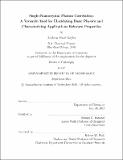Single-nanocrystal photon correlation : a versatile tool for elucidating basic physics and characterizing applications-relevant properties
Author(s)
Beyler, Andrew Paul
DownloadFull printable version (26.32Mb)
Alternative title
Versatile tool for elucidating basic physics and characterizing applications-relevant properties
Other Contributors
Massachusetts Institute of Technology. Department of Chemistry.
Terms of use
Metadata
Show full item recordAbstract
Single-molecule spectroscopy has been a critical tool for the development and understanding of semiconductor nanocrystals because of their inherent heterogeneity size-dependent properties. In the past two decades, researchers have developed a diverse toolbox of single-nanocrystal techniques and analyses that is capable of elucidating the complex physics of nanocrystal fluorescence and characterizing many of the subtle but important optical properties of nanocrystal samples. This effort has been enabled by the flexible and modular structure of the single-molecule microscope, which offers a multitude of opportunities for shaping the information gained from single-nanocrystal experiments and provides a convenient and powerful framework for creativity in experimental design. In this thesis, we present two investigations that illustrate the full range and versatility of single-nanocrystal spectroscopy and, in particular, of photon correlation analysis. In Part I, we use single-nanocrystal spectroscopy as a tool for elucidating basic physics by investigating the rapid spectral diffusion of individual nanocrystals at low temperature. We develop a technique capable of measuring spectral dynamics over eight orders of magnitude in time ranging form microseconds to hundreds of seconds, and show that we can extract previously unavailable information about the spectral diffusion mechanism. In Part II, we use single-nanocrystal spectroscopy as a tool for characterizing optical properties by devising an experiment to measure the average biexciton quantum yield of nanocrystal samples. This experiment allows us to measure the biexcitonic properties of underdeveloped materials and can serve as a quick and reliable characterization technique to aid in synthetic optimization. Finally, in Part III, we look to the future by highlighting several modifications of existing experiments that could reveal new and exciting insight into nanocrystals.
Description
Thesis: Ph. D., Massachusetts Institute of Technology, Department of Chemistry, 2015. This electronic version was submitted by the student author. The certified thesis is available in the Institute Archives and Special Collections. Cataloged from student-submitted PDF version of thesis. Includes bibliographical references (pages 299-327).
Date issued
2015Department
Massachusetts Institute of Technology. Department of ChemistryPublisher
Massachusetts Institute of Technology
Keywords
Chemistry.